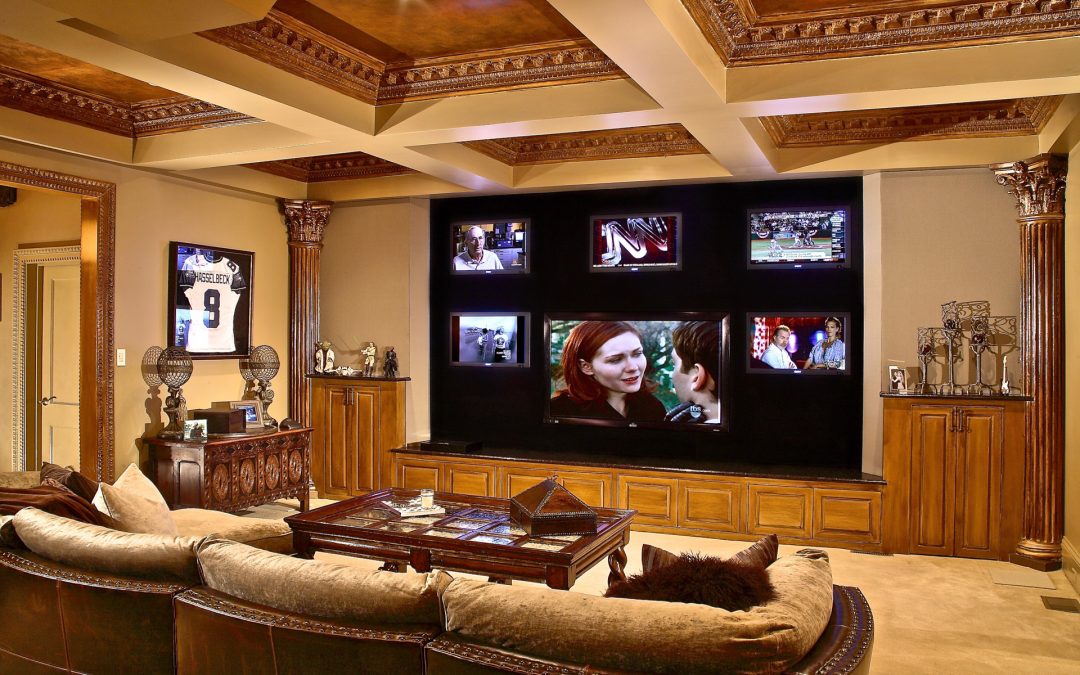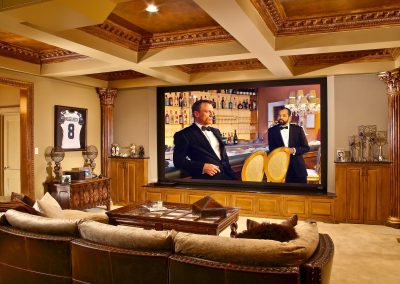By Paul Griffith Nashville Interiors, Vol. 6, 2006-2007
Carl Tatz is an acoustic designer, and when it comes to home theaters, nobody else in Nashville can say that. With a background in the recording arts and monitor system design, Carl is exceptional because he combines top-flight audio engineering skills with design expertise and an appreciation for aesthetics. As the owner of Carl Tatz Design, he has installed state-of-the-art home studios and home screening rooms in upscale homes from coast to coast. “I’m able to take the extreme tech side and bring that into a screening room; that’s what makes my work unique,” says Carl. “Having designed studio sound systems, I bring that level of precision into the home theatre, and it makes people’s jaws drop. The end result can look any way the client wants––old-fashioned with a popcorn machine, or straight out of Star Wars––it doesn’t matter; it’s the performance that I do. With both the sound and the feel of the room, I want the “wow” before the movie even starts.” Carl became obsessed with movies and sound at a young age. As a boy growing up in Providence, Rhode Island, his family ran a drive-in movie theatre. From the projection booth, he drank in the classic films of the 60s––all the while absorbing the basics of film projection and sound. As a young man, he moved to Nashville and worked as a bass player. Eventually, he began writing songs and holding recording sessions in his home. As business increased, he founded Recording Arts, which, over the next eighteen years, became a legendary recording facility that was home to hits by Dolly Parton, Faith Hill and many more. In 2003, Carl sold Recording Arts to pop superstar Sheryl Crow. While operating Recording Arts, Carl began conceptualizing what he calls the “PhantomFocus System™,” which is now at the heart of every screening room he designs. With PhantomFocus, he can literally tune a room by using established audio protocols––with the help of audio imaging devices and an array of computer hardware and software. By manipulating hyper-technical elements like speaker/listening position, sound dampening devices, equalization, laser alignment and phase control, Carl can recreate, in the home, the same screening experience enjoyed by film directors on Hollywood dubbing stages. These home-screening rooms can be dedicated environments, which are like mini-theatres, or multi-purpose rooms that convert readily back to elegant living rooms or comfy dens. “I love movies,” says Carl. “And being a musician, I love the sound part especially. Having a really wide screen, and making the sound come from that…regular hi-fi speakers just aren’t appropriate. Because I’m an acoustic designer-slash-builder, that means that I’m not just a hi-fi salesman, and I don’t have to sell what’s on the shelf. I assist my clients in creating a custom solution for their vision of what they want their home theatre to be. Of course, I do provide the audio and video gear, but because I’m an independent designer, I’m not required to push a particular brand of projector or speakers. That gives me a free hand in recommending whatever gear I believe will best suit the project.” In most cases, the process of installing a home screening room begins with a consultation. Carl meets with his client to suss out their needs and determine the scope of the project. “It’s like counseling,” he says. “I listen closely to what they say then ask a thousand questions to begin to glean what they’re looking for. We’ll get an idea, and I get excited, then we’ll come up with a sketch. It can look like anything you want––though I lean toward more serious approaches, I once had a client who wanted me to make it look like the Grand Ole Opry. No problem.” The resulting projects can be small or large scale, which will result in either outpatient treatment or major surgery when it comes to the interior of your home. Architecturally, Carl routinely consults with the best, and he has several local contractors that assist him with the structural phase of his designs. “I make it work,” Carl says. “I love working with interior designers and architects when the project calls for it and I like to get in on the ground floor, during the home construction phase or during a remodel. A lot of people worry that this guy’s going to come in and take over, run roughshod over their home design, but it shouldn’t be a war. This is collaboration; I’m not going to design this, you are. And the way it looks is absolutely as important as the way it performs.”By Paul Griffith Nashville Interiors, Vol. 6, 2006-2007
Carl Tatz is an acoustic designer, and when it comes to home theaters, nobody else in Nashville can say that. With a background in the recording arts and monitor system design, Carl is exceptional because he combines top-flight audio engineering skills with design expertise and an appreciation for aesthetics. As the owner of Carl Tatz Design, he has installed state-of-the-art home studios and home screening rooms in upscale homes from coast to coast. “I’m able to take the extreme tech side and bring that into a screening room; that’s what makes my work unique,” says Carl. “Having designed studio sound systems, I bring that level of precision into the home theatre, and it makes people’s jaws drop. The end result can look any way the client wants––old-fashioned with a popcorn machine, or straight out of Star Wars––it doesn’t matter; it’s the performance that I do. With both the sound and the feel of the room, I want the “wow” before the movie even starts.” Carl became obsessed with movies and sound at a young age. As a boy growing up in Providence, Rhode Island, his family ran a drive-in movie theatre. From the projection booth, he drank in the classic films of the 60s––all the while absorbing the basics of film projection and sound. As a young man, he moved to Nashville and worked as a bass player. Eventually, he began writing songs and holding recording sessions in his home. As business increased, he founded Recording Arts, which, over the next eighteen years, became a legendary recording facility that was home to hits by Dolly Parton, Faith Hill and many more. In 2003, Carl sold Recording Arts to pop superstar Sheryl Crow. While operating Recording Arts, Carl began conceptualizing what he calls the “PhantomFocus System™,” which is now at the heart of every screening room he designs. With PhantomFocus, he can literally tune a room by using established audio protocols––with the help of audio imaging devices and an array of computer hardware and software. By manipulating hyper-technical elements like speaker/listening position, sound dampening devices, equalization, laser alignment and phase control, Carl can recreate, in the home, the same screening experience enjoyed by film directors on Hollywood dubbing stages. These home-screening rooms can be dedicated environments, which are like mini-theatres, or multi-purpose rooms that convert readily back to elegant living rooms or comfy dens. “I love movies,” says Carl. “And being a musician, I love the sound part especially. Having a really wide screen, and making the sound come from that…regular hi-fi speakers just aren’t appropriate. Because I’m an acoustic designer-slash-builder, that means that I’m not just a hi-fi salesman, and I don’t have to sell what’s on the shelf. I assist my clients in creating a custom solution for their vision of what they want their home theatre to be. Of course, I do provide the audio and video gear, but because I’m an independent designer, I’m not required to push a particular brand of projector or speakers. That gives me a free hand in recommending whatever gear I believe will best suit the project.” In most cases, the process of installing a home screening room begins with a consultation. Carl meets with his client to suss out their needs and determine the scope of the project. “It’s like counseling,” he says. “I listen closely to what they say then ask a thousand questions to begin to glean what they’re looking for. We’ll get an idea, and I get excited, then we’ll come up with a sketch. It can look like anything you want––though I lean toward more serious approaches, I once had a client who wanted me to make it look like the Grand Ole Opry. No problem.” The resulting projects can be small or large scale, which will result in either outpatient treatment or major surgery when it comes to the interior of your home. Architecturally, Carl routinely consults with the best, and he has several local contractors that assist him with the structural phase of his designs. “I make it work,” Carl says. “I love working with interior designers and architects when the project calls for it and I like to get in on the ground floor, during the home construction phase or during a remodel. A lot of people worry that this guy’s going to come in and take over, run roughshod over their home design, but it shouldn’t be a war. This is collaboration; I’m not going to design this, you are. And the way it looks is absolutely as important as the way it performs.”


